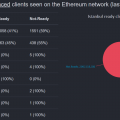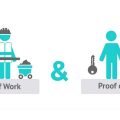How secure are systems based onProof-Of-Stake, how fast they are and what's wrong with (de)centralized social networks. The founder of Synergis and co-author of the book «Web 3.0 answered these questions specifically for ForkLog. The present of yesterday's tomorrow» Vladimir Popov.
</p>Tron vs. Steem (it), or usurpation on the ground
More precisely, Tron versus Steem, but the conflictstarted with Steemit. Justin Sun bought a stake in Steemit (which is essentially a Dapp on the Steem blockchain) and then tried to move all of Steem to the Tron blockchain. The community didn't like it — Hive hard fork took place.
Who's guilty?Both sides.The Steem community turned out to be close-knit, but rather lazy. It woke up from a thirty-fold increase in staking value only when it played a cruel joke on it. San took his charter to someone else's monastery and even attracted some exchanges that managed to use user coins for voting.
This suggests that the (D / L) PoS problemthe seizure of power, known since the time of cooperatives and barbaric raiding, has not been resolved. In PoW, for example, the centralization of pools since 2018 is only visual. Nominally, TOP pools are located in China, but the location of nodes and miner communities shows that physical equipment is available in Siberia, Chile, Venezuela, Canada, and the United States. The leader of mining has also changed: China, Russia, USA ...
What to do?One potential solution I was able to find isFair DPoSin which voting for delegatesassumes that the stake (stake) of the participant is divided by the number of votes. For example, a participant with a share of 100 tokens voted for delegates A and B. Blockchain will take into account that everyone received 50. If, however, he voted for three, then everyone will receive 33.33. This allows to level the ability of a major holder to put the necessary delegates in the TOP, and also eliminates corruption.
Everyone who talks about the advantages of (D/L)PoS overPoW and forgets about this aspect, at best they are lying, and at worst — trying to deceive neophytes who are ready to invest and receive their «legitimate» 5% monthly payments. Not to mention the fact that the holder may even turn out to be a fraudster. This case has not yet been well studied — even if the coins are frozen for 10-13 weeks, the question remains open.
In a word, there is a risk of losing everything because of the management system, even if it seems that the change of ownership does not mean anything.
EOS — project that killed itself
I like Bitshares and Graphene, but EOS from the very beginning showed how you can, but you do not need to earn material capital, losing social.
Essentially the longest ICO in historywas an almost endless (about a year) token sale, which worked according to the greed formula: emission ->purchase -> price increase -> emission -> price decline -> purchase -> new circle. Block.one managed to raise more than $4 billion (and then fell out of favor with the SEC).
EOS has other disadvantages as well.Firstly, very expensive «energy». A developer once told me: «we are planning [for this reason] to switch to WAX». The strangest thing is that you cannot pay for the transaction: buy and buy energy! In addition, in EOS it is possible, albeit conditionally, to change smart contracts. The level of trust in such — extremely low. Among other disadvantages: there is no NFT standard, limited free nodes, no convenient SDK for unit tests, etc.
Of course, all the cons can be turned into pluses: interpret the same replacement of smart contracts as simplicity in adding options and testing bugs. You can create several operations in one transaction or clean the memory and sell it (environmentally friendly).
But the fact remains a fact — The advantages announced during the ICO not only did not eliminate Ethereum’s problems, but also gave rise to their own. This looks especially bad compared to the role of EOS whales.
DASH: why doesn't PoW / PoS help?
I often hear that the trade-off between PoW and PoS— perfect solution. This approach was adopted by Dash, Zilliqa, Decred and some other projects. But in reality, everything turned out to be not quite like that.
In Dash, 90% of the block reward is distributedbetween miners and masternode operators. Masternodes are needed for two operations: PrivateSend and InstantSend. The first allows you to specify the required number of shuffles to increase the level of anonymity, and the second — for conditionally instant transactions.
Something went wrong? The biggest disappointment was the terribly expensive D3 miners who didn’t pay for themselves that way. Delayed supplies, the hype at the end of 2017 and the fall in prices played a role.
The architecture may look right, but there are always gaps for epic failures.
If they sell something, it’s profitable for someone.
Person of the Year 2019: Greta Thunbergwhich once again attracted the attention of the whole world to the problem of global warming, although greening has long been in trend. Salesmen of masternodes of various kinds (D/L)PoS systems are taking advantage of the situation, promoting the claim that mining — bad for the planet. They are silent on three facts:
- Heat from many mining farms is used toheating greenhouses, houses, shopping centers, to generate new energy. The harmful effects of mining are often overestimated. In Ethiopia Hidase alone (HES), 6.45 GW exceeds all bitcoin mining (a little over 5.5 GW).
- The architecture of (D / L) PoS systems does not implya large number of participants. In PoS systems, 1000 already seems big. When scaling, given the network effect and Metcalf's law, it is likely that the hardware will survive the same evolution as in traditional mining. No one has canceled the ping problem (due to the geo-referencing of the same nodes), network bandwidth, and other characteristics that can be used at the program level only to a certain limit. Just remember how Google and Facebook work. Sharding also hides the possibility of increasing capacity for storage, computing, etc.
- It’s not for nothing that PoS has so many modifications:DPoS, LPoS, PoS, POI, etc. The difference in rights, opportunities, and responsibilities of various network participants: in the event of a war on «hardware» only the rich will win.
If you forget about the standard whitepaper workbitcoin, but to move on to real-life calculations, you will need GPU power. And data cannot be stored on centralized servers or in the Amazon cloud — here Proof-of-Spacetime and Proof-of-Replication come to the rescue, which are used, for example, in FileCoin, Storj, Sia. As a result, we still return to PoW, albeit in a different form.
Ecological marketing moves are not the only ones in the arsenal of salespeople (D / L) of PoS systems.
Let's take material A as an example.Kolyaeva: voting in ⅔ in Tendermint — the process is very efficient as long as no discrepancies arise. With its help you can not only «get» blocks, but also approve any value/work/result. This achieves the required level of security, but at the same time creates accessibility problems.
Could it be that ⅔ wasn’t enough?Completely, which means — simple and waiting. It’s good that after approval the result is recorded as final, but Ethereum has uncle blocks — additional bonus for all miners.
In my opinion, the main problem is howthe specific weight of the node that the algorithm selects is determined. In short, this is the number of locked coins. What is the problem? So this is a bank! Who is richer, that and slippers.
And one more thing: 1000 nodes are somehow not enough for the world.In Bitcoin, where nodes are not paid anything, there are approximately 10,000 of them; in Ethereum — more than 7,000. And this is not bad, since there is no upper limit. But 1000? There are 442 banks in the Russian Federation, although 20 years ago there were 1,311. And this is only for 145 million people, while there are already 7.5 billion on the planet, and there will be even more. 1000 does not look like an impressive number, but this is another level of manipulation — Yes.
Validators can be susceptible to the same problem:the same ones that were born through IBC. I will quote: “if you send an IBC transaction from blockchain A to blockchain B through the hub, then you must trust the validators (nodes that participate in the consensus) of blockchain A, the hub and blockchain B.” Many believe, and not without reason, that such an approach can be read as “training to pay bribes.”
It turns out quite diverse andhigh-tech garden: we have nodes, validators, snapshots and «fishermen» with challenges, which can ultimately lead to chain rollbacks. That is, what did they leave — chain with large proof of work — That's what we came to. But then what is the value of the approach?
Especially a lot of questions arise when there is noatomic swaps between PoW blockchains that are synchronized via IBC, Polkadot, Ethereum, and at the same time, a rollback to the desired block occurs inside the selected and connecting multiblockchain. I have not yet seen design models where all the costs and related security problems will become clear.
Why all this at all?
Sometimes I ask myself the same question, but there is still an answer. Speed. The same onesTps.
As CTO The Power noted:«from a technical point of view, all types of PoS are aimed at gaining speed compared to classical systems. There are other solutions besides PoS. It’s just that PoS was the first, most likely as an option lying on the surface. But the first method that came to mind — not always the best. This is what we are seeing now, when PoS platforms stand the test of time.
There is another misconception in this race.Visa/Mastercard does not have any 20-50 thousand Tps. Real indicators — from 3500 to 4000 Tps. Ripple's XRP Ledger makes 1500 Tps. Zilliqa, as well as PoW blockchains Tera and Kadena, have excellent performance.
But 100 thousand and even 1 million Tps may very soon be needed: why?
- IoT.
- decentralized social networks (DSS).
Here the position of developer A is close to me.Piskunova: “What is a real DSS? First of all — direct subscription. Everyone sees only what they subscribe to. And they see you only when you create (initiate) the corresponding transaction. In fact, this is what the Bitcoin network and other open solutions are built on.”
This approach requires more informed decisions anddiligence, since everyone is tasked with independently expanding the circle of acquaintances, but you can use triggers: circle of interests, certain learning algorithms (wrote «hello world» — follow further), etc., which is optional , but a necessary condition for evolution. No one can cancel their subscription to tags/topics either.
What's good about this approach?Firstly, it automatically filters out spam. If you are not subscribed, spam will not be sent (today it is enough to know the address/nickname). Secondly, “you only see what you look at”: no simulacra! Of course, no one forbids introducing recommendations, but they will be based on user self-education, not marketing.
Only this approach can solve the eternal problems of our community:
- My (private) key = my money!
- My assets — best hedge fund!
- No intermediaries needed — It's me they need, so they can be data oracles, but if I want it and do the validation.
And here we slowly but surely approach the maina problem that overshadows all others: it has long been not technical (although that too), but social. We trust: banks, search engines, social networks, and thereby — we pay them three times:
- Paying taxes / fees / inflation / exchange rate differencescurrencies. The state creates rules (laws and other regulations) that ultimately help corporations. Even the GDPR looks like protecting citizens, but in fact it turns us into digital slaves of services. I’m silent about the Spring package in the Russian Federation or the Snowden / Assange data for the USA, China and other countries. For us, the account is managed by us.
- Rule «if you do not buy any product, thenyou are the product» works flawlessly. The data is eavesdropped by Siri/Alisa/Google Assistant, it is stored through many .js scripts on websites. Oil of the digital age — big data And it does not belong to us, although every drop — this is us. You can (and sometimes need to) sell your data, but you also need to make a profit from it.
- We pay directly by buying advertising campaigns, placing ads, purchasing subscriptions.
At the same time, Facebook blocks cryptocurrency ads, and then creates Libra. Tax-assisted ILV can block almost any website and cause problems for business.
So I started studying (D/L)PoS systems.Many DSS prototypes have been made on their basis, but to say that they have success ahead — stupid. Product development, as the ICO boom has shown, is about more than just a good team and the right idea.





